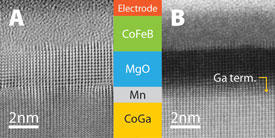

02/25/2019

Reprinted, with permission, from Ref. 1. Copyright (2019) American Chemical Society.
A solid-state structure that is promising for realizing extremely fast magnetic storage devices with ultralow power consumptions has been fabricated by AIMR researchers1.
A magnetic tunnel junction consists of two magnetic layers separated by a non-magnetic, insulating layer. Information can be stored and erased by switching the relative magnetization of the two layers, which is usually done by an electric current flowing through the junction.
A faster, more efficient way to switch magnetization would be to vary the magnetic anisotropy, that is, the variation of magnetic properties of the structure with the direction of an applied magnetic field. Ideally, the magnetic anisotropy would be controlled by an electric voltage, but it has been difficult to find materials that exhibit voltage-controlled magnetic anisotropy.
Research efforts to date have focused on magnetic tunnel junctions based on ferromagnetic cobalt iron boron (CoFeB), but since ferromagnetic materials tend to generate large stray magnetic fields, they cannot be used to fabricate high-density integrated storage devices.
Now, Kazuya Suzuki of the AIMR at Tohoku University and his colleagues have used a new ferrimagnet, which generates negligible stray fields, to realize a magnetic tunnel junction that exhibits voltage-controlled magnetic anisotropy. They achieved this by including a very thin layer of manganese grown on cobalt gallium (CoGa) in the junction. Although manganese is anti-ferromagnetic or paramagnetic in bulk, their studies had shown that a nanolayer grown on cobalt gallium would be ferrimagnetic and possess perpendicular magnetic anisotropy.
The junction fabricated by Suzuki and co-workers included a manganese nanolayer grown on a cobalt gallium seed layer and capped by a magnesium oxide tunnel barrier and a magnetic cobalt–iron–boron layer (see image). Measurements of the electrical resistance through the structure when a magnetic field was applied parallel and perpendicular to the junction indicated that the manganese nanolayer possesses a large perpendicular magnetic anisotropy. Furthermore, the shape of resistance curves varied with the applied voltage. This shows that the structure exhibits voltage-controlled magnetic anisotropy, which is very likely due to the electric-field modulation of the electronic structure at the interface between the manganese and magnesium oxide.
The results could open a new line of research in magnetic tunnel junctions. “This concept might be widely used for other manganese-based nanolayers,” says Suzuki. “We will do further research into other non-ferromagnetic manganese-based materials that convert to a perpendicular magnetized nanolayer. This research and concept will promote the development of new perpendicular magnetic materials for future spintronic storage devices.”
This research highlight has been approved by the authors of the original article and all information and data contained within has been provided by said authors.